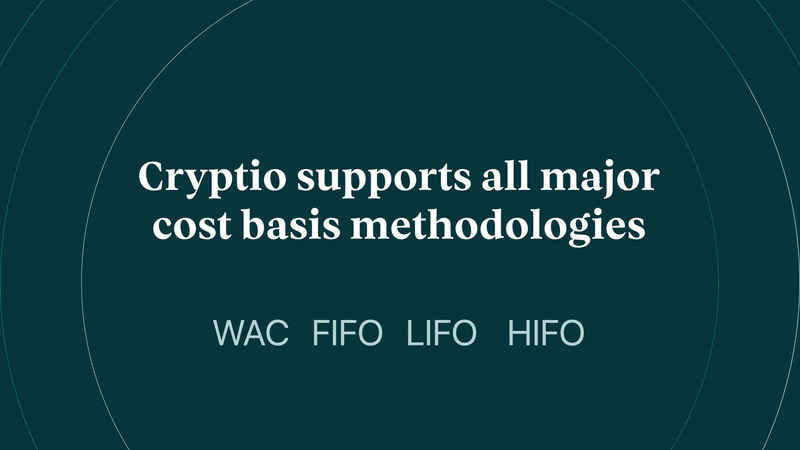Workspace cost basis methodology
Selecting the correct cost basis methodology is a key part of establishing accurate accounting records. It is also critical for complying with tax standards around gains and losses.
What is cost basis?
Cost basis is the price you paid to purchase an asset or investment. This value is used to calculate capital gains or losses, which is the difference between the selling price and the purchase price.
There are four main ways to calculate cost basis for digital assets (also called cost basis methodologies):
FIFO – First In, First Out
WAC – Weighted Average Cost
LIFO – Last In, First Out
HIFO – Highest In, First Out
You can apply these methodologies either to your entire workspace (universally) or to individual sources (per wallet).
We typically recommend using the per-wallet approach whenever possible, as it provides more clarity and granularity in your reporting.
All four methodologies are compliant with both IFRS and US GAAP requirements.

Cost basis methodologies with examples
FIFO – First In, First Out
Under FIFO, the first tokens acquired are the first tokens counted when a sale or taxable event occurs.
Example:
Purchase 1 ETH on 5/1 for $2,000
Purchase another 1 ETH on 5/2 for $2,500
Sell 1 ETH on 5/7 for $2,600
Here, the cost basis is $2,000, and the realized gain is $600 ($2,600 – $2,000).
WAC – Weighted Average Cost
This method uses the average price paid for all tokens as the cost basis.
Example:
Purchase 1 ETH on 5/1 for $2,000
Purchase another 1 ETH on 5/2 for $2,500
Sell 1 ETH on 5/7 for $2,600
The cost basis is the average of the two purchases:
($2,000 + $2,500) ÷ 2 = $2,250
The realized gain is $350 ($2,600 – $2,250).
LIFO – Last In, First Out
Under LIFO, the most recent tokens acquired are the first tokens counted when a sale or taxable event occurs.
Example:
Purchase 1 ETH on 5/1 for $2,000
Purchase another 1 ETH on 5/2 for $2,500
Sell 1 ETH on 5/7 for $2,600
Here, the cost basis is $2,500, and the realized gain is $100 ($2,600 – $2,500).
HIFO – Highest In, First Out
HIFO uses the highest purchase price of your tokens as the cost basis.
Example:
Purchase 1 ETH on 5/1 for $2,000
Purchase another 1 ETH on 5/2 for $2,300
Purchase another 1 ETH on 5/3 for $1,800
Sell 1 ETH on 5/7 for $2,600
Here, the cost basis is $2,300, and the realized gain is $300 ($2,600 – $2,300).
Need help selecting the right methodology?
If you need deeper guidance on selecting the right methodology, read our blog written by Cryptio’s Accounting Strategy team.
How to set up your preferred cost basis methodology
You need to set up your cost basis methodology when creating a new workspace.
In the Cryptio platform, click the ^ icon next to your workspace name in the top-left corner.
From the dropdown, select Manage workspaces.
Click + Workspace and the workspace creation menu will open.
Enter the Name, Description, Currency, and Timezone.
Under Cost basis methodology, select your preferred method.
Click Create.
You can also set up a per-wallet methodology for more detailed reporting.
Can I change the cost basis methodology on Cryptio?
Yes, you can change your cost basis methodology at any time in your workspace settings.
Important: Changing your cost basis methodology frequently — for example, every year to reduce your tax bill — may be heavily scrutinized by auditors. This can also have legal or tax implications. The cost basis methodology is primarily intended for accurate and consistent valuations, not for tax savings. We recommend consulting a tax or legal advisor before making changes.
For step-by-step setup, see our guide: Cost Basis Data Migration Guide